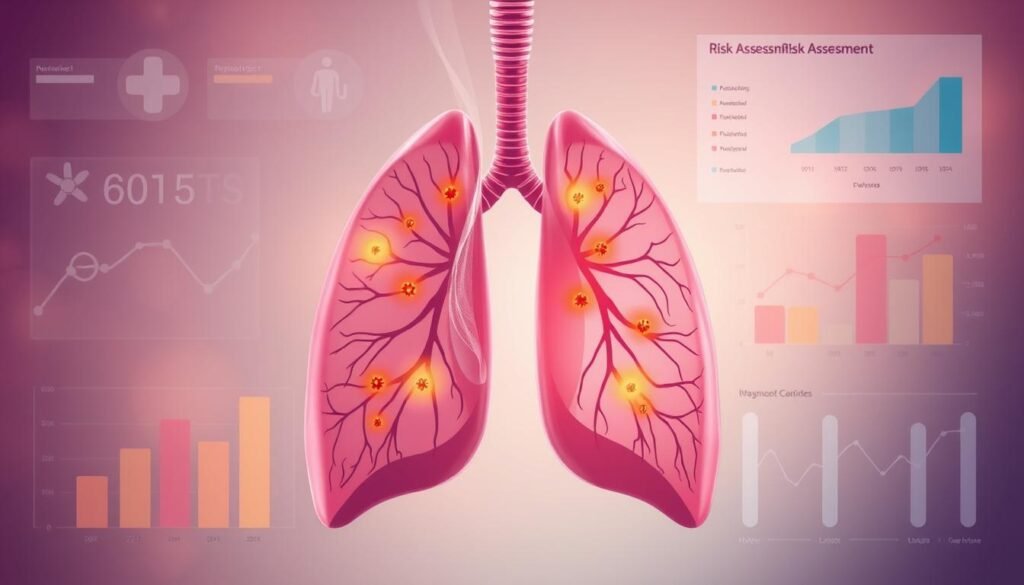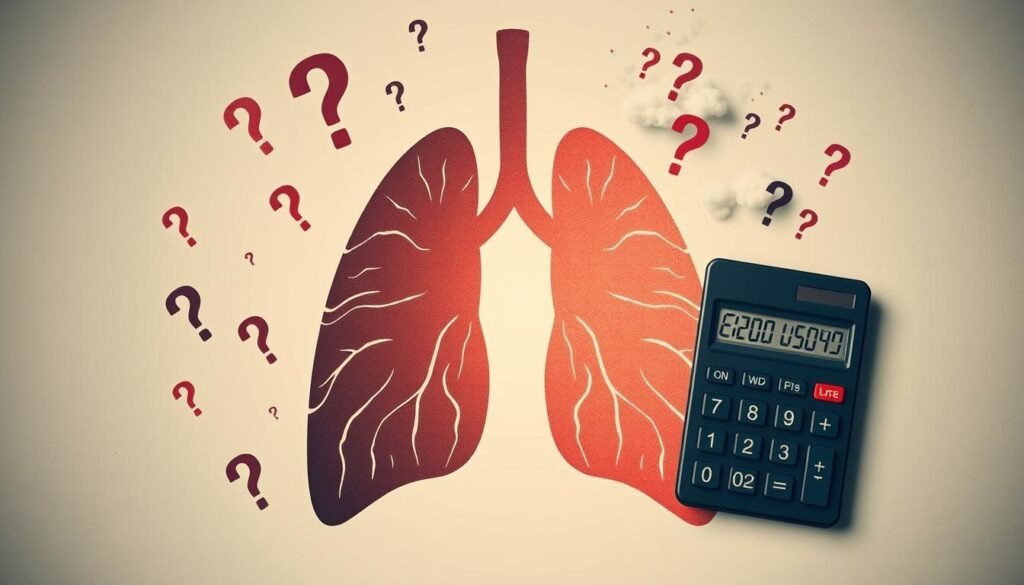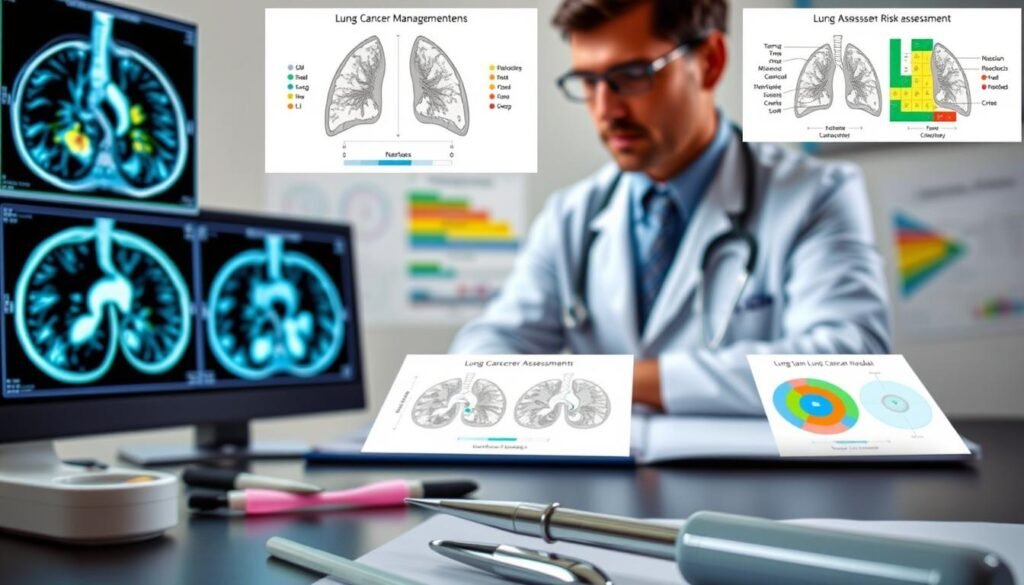About 1 in 4 lung cancer cases are found at a late stage. This makes treatment harder to do. The Lung Cancer Nodule Risk Calculator is important. It is a risk assessment tool for checking lung health. It looks at lung nodules in CT scans to see if they might be cancer. This helps people get care early, which can lead to better results.
The free assessment lets users give specific details. These details help doctors decide what to do next. For more on lung cancer and how it’s classified, read this World Health Organization page on TNM classification.
Key Takeaways
- The Lung Cancer Nodule Risk Calculator provides crucial insights into lung health.
- Accurate risk assessment can lead to timely and effective medical intervention.
- Using the calculator can empower healthcare providers and patients in treatment planning.
- Understanding the characteristics of pulmonary nodules is essential in evaluating lung cancer risk.
- This free tool facilitates informed decision-making for better patient outcomes.
Understanding Lung Cancer and Pulmonary Nodules
Lung cancer is a major health issue worldwide, with about 1.8 million new cases each year. In the U.S., about 224,000 people are diagnosed annually, leading to 159,000 deaths. It’s crucial to know the risk factors and diagnostic methods to manage lung cancer well.
What is Lung Cancer?
Lung cancer starts in the lungs and comes in different types, with non-small cell lung cancer (NSCLC) being most common. Finding it early is key to improving treatment success and survival. Smoking, being around certain environmental toxins, and genetics increase the risk. Knowing these can help people watch their lung health closely.
The Role of Pulmonary Nodules in Lung Cancer Diagnosis
Pulmonary nodules are small growths in the lungs caused by various factors, such as infections, benign tumors, or lung cancer. It’s critical to check these nodules to diagnose lung cancer accurately. Between 17–51% of chest CT scans show pulmonary nodules that could be cancerous, with a risk of 1–12%. Thanks to better detection methods, it’s now easier to find these nodules early, which helps with managing the patient’s health and catching issues sooner.
Lung Cancer Nodule Risk Calculator: An Overview
The lung cancer nodule risk calculator is key for doctors to assess lung nodules. It helps determine the risk of cancer, guiding treatment plans. Knowing the risks leads to faster and better care for patients.
Purpose of the Risk Calculator
This tool offers a science-backed way to judge if pulmonary nodules might be cancerous. It sorts nodules into low, medium, or high-risk. This helps doctors decide on the next steps for tests or treatment.
Key Predictors of Malignancy in Nodules
Many factors affect how likely a nodule is to be cancerous. These include:
- Patient smoking history
- Age of the patient
- Nodule size
- Morphological characteristics of the nodule
Considering these factors helps doctors understand risk levels. This improves lung cancer screening and care planning.
How the Risk Calculator Works
The risk calculator is a vital tool for checking lung nodules. It requires specific information to work well. This info helps figure out if a nodule might be cancer. It also guides what steps to take next. Knowing how to use this calculator is key in lung cancer care and making choices for health.
Input Parameters Needed for the Evaluation
To see if a lung nodule could be cancer, the risk calculator needs certain details. Some of the main things it looks for are:
- Smoking Status: It’s important to know if someone is smoking or used to smoke.
- Patient Age: How old someone is plays a big role in risk level.
- Nodule Size: This is measured to understand the nodule better.
- Duration Since Quitting Smoking: How long it’s been since quitting affects risk too.
- Additional Features: Other factors like the nodule’s look or if there’s already lung issues matter as well.
Interpreting Your Results
After putting in all the information, the calculator gives us a risk score. Understanding these results is crucial for doctors. They decide what to do next based on the score. For instance, a nodule looking a certain way may need more checks. This calculator is really important in planning health care, according to guidelines.
Clinical Models for Lung Nodule Risk Assessment
It’s important to know the clinical models for lung nodule risk to predict lung cancer effectively. The VA Clinical Model and the Mayo Clinical Model are key players. They help figure out how likely lung nodules are to be cancerous. This informs healthcare providers on the best way to manage their patients.
VA Clinical Model Explained
The VA Clinical Model uses a simple method. It looks at four main factors:
- Smoking status
- Years since quitting
- Age
- Nodule size
By evaluating these, it scores nodules as low, intermediate, or high-risk. This model values patient history, improving lung nodule risk assessment.
Mayo Clinical Model Explained
The Mayo Clinical Model, however, uses six factors. It’s a detailed tool for lung cancer risk estimation. It considers nodule traits and patient data. A study shows its AUC is 0.75. This means it’s good at spotting potential cancer in unexpected nodules.
Both models underline the role of patient history for accurate risk evaluation. They are crucial for early cancer detection. This is vital, as shown in recent research.

Advantages of Using a Lung Cancer Nodule Risk Calculator
The Lung Cancer Nodule Risk Calculator is a big help in lung health. It offers fast and right-on-target risk evaluations which are key for catching lung cancer early. This is especially true in areas lacking good screening programs. The calculator makes it easier for doctors to figure out who needs closer watching.
Timely and Accurate Risk Assessment
This tool stands out because it quickly handles important lung nodule information. Facts show using a risk calculator greatly cuts down on false alarms common with older screening ways. These false alarms can be as high as 96.4%. By having precise testing, it boosts a person’s chances of beating lung cancer. The current survival rate worldwide is only 10% to 20%.
It also uses smart technology to better pinpoint who truly needs more tests. This helps patients avoid stress and saves time and resources.
Guiding Clinical Decision-Making
Doctors make better choices with help from the Lung Cancer Nodule Risk Calculator. It takes complex info from different models, making it easier to manage patients. This means when used with other tools and methods, doctors can really zoom in on who needs what treatment.
This organized way of working lets doctors plan care that fits each patient’s needs closely. Patients then get the right monitoring and treatment without delays.
Limitations and Considerations
Using calculators to assess lung cancer risk is a big step forward in early diagnosis. However, there are important limitations to consider. The accuracy of these assessments can vary greatly. This is due to differences in patients, nodule characteristics, and other health conditions. Each factor can change how well the risk calculator works, affecting lung cancer diagnosis accuracy.
Factors Influencing Risk Assessment Accuracy
Understanding the varied factors that affect the risk assessment is essential. These can include:
- Variability in patient health profiles
- Nodule size and growth rate
- Details about the nodule’s appearance, like its density
- Patient history, including smoking and other health issues
- New advances in imaging tech and clinical guidelines
The combined effect of these factors influencing assessment can cause differences in calculator results. For instance, just using nodule size to assess risk has limits. But, advanced predictive models, as shown in several studies highlight the importance of nodule characteristics, are helping overcome these limits.

Doctors need to consider these factors to better understand risk calculator results. Focusing on thorough evaluations can help make better decisions. This can lead to better care for people being checked for lung cancer.
Implications of Risk Assessment in Lung Cancer Screening
Early detection is key in fighting lung cancer. Finding the disease early improves chances of beating it and living longer. It’s vital to spot high-risk patients quickly to start tests and treatment right away.
Importance of Early Detection
Early detection is critical in fighting lung cancer. In 2020, about 228,820 people were diagnosed with it in the U.S. Sadly, 135,720 died. Screening, especially for those 50 to 80 who smoked a lot, is recommended. An annual low-dose CT scan can catch cancer early, saving lives.
How Risk Scores Affect Patient Management
Risk scores help doctors manage lung cancer care. They guide decisions on further tests, monitoring, or starting treatment. Despite some prediction errors, it’s important for doctors to use these tools wisely. For more on their accuracy, check out this study.
Nodule Management Strategies Based on Risk
Managing nodules based on their risk helps ensure patients get the right care. For each risk level, there’s a specific strategy. This ensures care is both efficient and effective.
Low-risk Management Approaches
Low-risk nodules are often watched with *surveillance*. This means using images over time to check any nodule changes. These low-risk approaches dodge unnecessary invasive tests. It’s key to look at the nodule’s size, shape, and symptoms.
Patient with these nodules usually do well. Lung cancer’s 5-year survival rate is 18%. This shows why spotting them early matters.
Intermediate to High-risk Management Approaches
For intermediate to high-risk nodules, action is crucial. Nodules with a 5% to 65% cancer risk might need a biopsy or surgery. This helps confirm if it’s cancer and what steps to take next. The way we look at the nodule, and the patient’s risk factors, guide us.
Signs like uneven edges or quick growth mean we need to act. These are big red flags for lung cancer. These signs guide our management plan.

Information on Malignancy Risk Prediction Models
Healthcare pros use several models to better diagnose lung cancer. These tools work alongside the Lung Cancer Nodule Risk Calculator. They help by giving more detailed risk assessments. The Brock and Herder models are notable examples. They use specific techniques to guess the risk of lung nodules accurately.
Additional Tools for Healthcare Professionals
Groups like the British Thoracic Society help improve lung cancer diagnosis. They use data from big studies to provide key stats. For example, research on 4,431 nodules identified 116 as malignant. The study set a 10% risk score as the best measure, with 85.3% sensitivity and 93.9% specificity.
The PLCOm2012 model gives a six-year risk estimate for people who have smoked. It closely matches with the PLCOall2014 model, showing a correlation of over 0.99. Validated models like PLCOm2012 showed an AUC of 0.797, proving their accuracy in risk prediction.
Also, there are two Excel calculators for clinicians. They help predict nodule malignancy chances from CT scans accurately. Moreover, an article in the New England Journal of Medicine talks about factors that alter cancer risk in lung nodules. It underscores the value of such prediction models.
Conclusion
The Lung Cancer Nodule Risk Calculator is a key tool in managing lung nodules. It helps doctors tell if nodules are benign or cancerous. This improves how lung cancer is treated. This tool gives patients vital info, helping them make informed choices.
A study showed some models predict cancer in nodules better than others. The Vancouver calculator was very accurate, with a 93% sensitivity rate. This shows how vital accurate risk assessment is. It leads to quicker, better care, improving patient survival rates.
Tools like the Lung Cancer Nodule Risk Calculator are becoming more important in lung cancer care. They help doctors make the best choices based on solid data. This leads to better care for people with lung nodules. For more on this topic, visit SpringerLink.